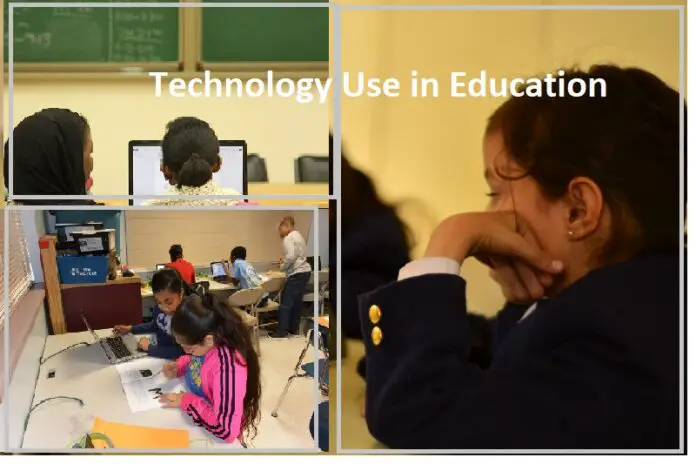The use of technology in education has revolutionized the way students learn and teachers instruct. It has become an integral part of modern educational systems, offering various benefits and opportunities.
Here are some key ways use of technology is education:
Online Learning Platforms:
Technology has enabled the development of online learning platforms that provide access to educational resources, courses, and materials from anywhere at any time. These platforms offer flexibility and convenience to students, allowing them to learn at their own pace.
Use of Technology in Education: Digital Content and E-books:
Traditional textbooks are being supplemented or replaced by digital content and e-books. Digital resources offer multimedia elements such as videos, interactive quizzes, and simulations, enhancing the learning experience and catering to different learning styles.
Collaboration and Communication Tools:
Technology facilitates collaboration among students and teachers, even when they are physically distant. Online tools like video conferencing, discussion boards, and messaging platforms enable real-time interaction, idea sharing, and group projects.
Personalized Learning:
Educational technology can adapt to individual student needs and provide personalized learning experiences. Adaptive learning platforms and intelligent tutoring systems use algorithms to analyze student performance and deliver tailored content and feedback to address their specific strengths and weaknesses.
Gamification and Simulations:
Gamification techniques, such as educational games and quizzes, make learning more engaging and enjoyable. Simulations and virtual reality experiences provide hands-on, immersive learning opportunities, especially in subjects like science, engineering, and medicine.
Data Analysis and Learning Analytics:
Technology allows educators to collect and analyze data on student performance, progress, and engagement. Learning analytics provide insights into student behavior and performance trends, enabling instructors to identify areas for improvement and make data-driven decisions.
Accessible Education:
Technology has improved access to education for students with disabilities or those in remote areas. Assistive technologies, such as screen readers and speech recognition software, enable students with disabilities to participate fully in educational activities.
Assessment and Feedback:
Technology has streamlined the assessment process, with digital tools facilitating automated grading, online quizzes, and immediate feedback. It saves time for teachers, provides prompt feedback to students, and supports formative assessment practices.
Virtual Field Trips and Global Connections:
Technology enables virtual field trips, where students can explore museums, landmarks, and other locations worldwide without leaving the classroom. It also facilitates global connections, allowing students to collaborate with peers from different cultures, fostering cross-cultural understanding.
Use of Technology in Education Professional Development for Teachers:
Technology offers numerous professional development opportunities for teachers. Online courses, webinars, and educational resources empower educators to stay updated with the latest teaching methods, instructional technologies, and subject knowledge.
Overall, the use of technology in education enhances access, engagement, and personalized learning experiences, preparing students for the digital age and empowering educators with valuable tools and resources.
Indeed, technology is one of the best tools in education due to its numerous advantages and transformative impact. Here are some reasons why technology is considered a valuable tool in education:
Use of Technology in Education Enhances Access to Education:
Technology has broken down geographical barriers and expanded access to education. It allows students from remote areas or with physical limitations to access educational resources, courses, and experts from around the world through online platforms.
Engages and Motivates Students:
Integrating technology into the classroom makes learning more interactive, engaging, and fun. Multimedia elements, such as videos, animations, and gamified activities, capture students’ attention and cater to different learning styles, leading to increased motivation and active participation.
Facilitates Personalized Learning:
Educational technology enables personalized learning experiences tailored to individual student needs and preferences. Adaptive learning systems and intelligent algorithms analyze student performance data to provide targeted content, exercises, and feedback, helping students learn at their own pace and address their specific areas of improvement.
Provides Rich and Diverse Learning Resources:
Technology offers a vast array of digital resources, such as e-books, online libraries, educational apps, and virtual simulations. These resources provide up-to-date information, diverse perspectives, and interactive experiences, enriching the learning process and broadening students’ knowledge.
Develops 21st Century Skills:
Technology in education prepares students for the demands of the digital age and develops essential skills for their future careers. By using productivity tools, collaborating online, conducting research, and solving problems with technology, students enhance critical thinking, creativity, digital literacy, communication, and collaboration skills.
Supports Differentiated Instruction:
Technology enables teachers to differentiate instruction to meet the diverse needs of students. They can provide additional resources, alternative learning pathways, and individualized support through digital platforms, helping students with different abilities and learning styles succeed.
Encourages Collaboration and Communication:
Technology facilitates communication and collaboration among students, teachers, and experts. Online discussion boards, video conferencing, and collaborative platforms enable students to work together, share ideas, provide feedback, and engage in meaningful interactions beyond the physical classroom.
Enables Data-Driven Decision Making:
Educational technology collects and analyses data on student performance, progress, and engagement. Learning analytics and data-driven insights help teachers identify areas where students may be struggling, adapt their teaching strategies, and provide targeted interventions to improve learning outcomes.
Fosters Lifelong Learning:
Technology equips students with the skills and resources to become self-directed learners. They learn how to find information, evaluate sources, and engage in continuous learning beyond the classroom, fostering a lifelong love for learning and preparing them for a knowledge-driven society.
Supports Professional Development:
Technology offers educators access to a wide range of professional development opportunities. Online courses, webinars, virtual conferences, and collaborative platforms enable teachers to stay updated with the latest pedagogical approaches, technology integration strategies, and subject matter expertise.
While technology is a powerful tool in education, it is essential to ensure its thoughtful integration, effective training for teachers, and appropriate use to maximize its benefits and minimize potential drawbacks.





